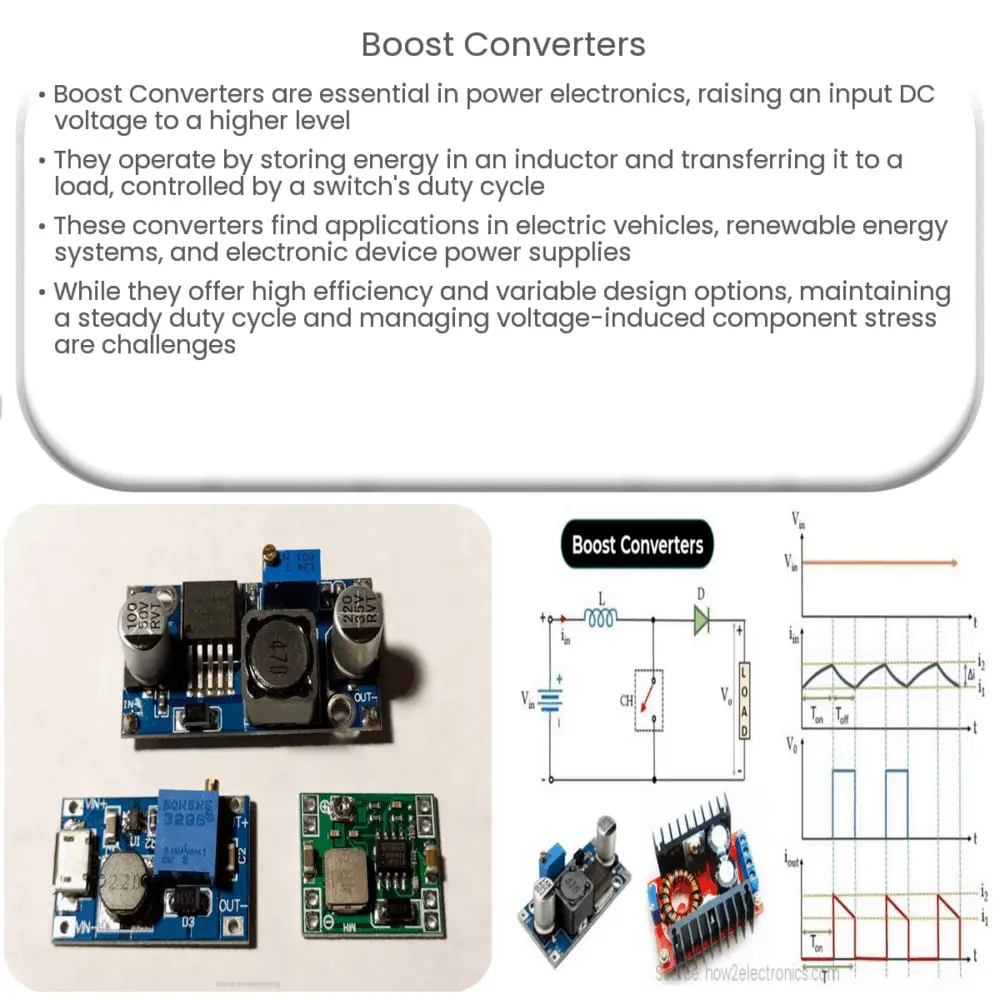Explore the workings of Boost Converters in power electronics, their key features, applications, design considerations, and types.

Understanding Boost Converters
A Boost Converter, a vital component in power electronics, is a DC-to-DC power converter known for its capacity to “boost” or increase an input voltage to a level higher than its initial value. It’s a crucial part of various electronics and vehicle applications, where a specific voltage level is required, but the power source is incapable of supplying it directly.
Operation of Boost Converters
At the heart of a Boost Converter’s operation lies the concept of energy transfer and storage. A typical Boost Converter consists of several key components: an inductor (L), a capacitor (C), a diode (D), and a switch (usually a transistor).
-
ON State: During the ‘ON’ state, the switch is closed, and the current through the inductor (L) increases, storing energy. The diode (D) is reverse-biased during this state, preventing energy transfer to the load.
-
OFF State: In the ‘OFF’ state, the switch is open, which forward-biases the diode (D) due to the inductor’s (L) stored energy. This energy is transferred to the load and the capacitor (C), effectively increasing the output voltage.
Key Features of Boost Converters
Boost Converters are valued for their multiple benefits in power electronics applications:
-
They can increase the DC input voltage, useful for applications that require higher voltage levels.
-
They have high efficiency, losing minimal energy in the conversion process.
-
They offer isolated and non-isolated designs, depending on the application requirements.
However, it’s essential to note that while Boost Converters offer numerous advantages, they also come with some challenges. The output voltage depends on the duty cycle of the switch, and maintaining a steady duty cycle can be complicated. Also, they can cause higher stress on the components due to increased voltage levels.
Applications of Boost Converters
Boost Converters are versatile, finding use in numerous applications across industries:
-
They are used in electric vehicles to convert the battery voltage to the required level for various systems.
-
They serve in renewable energy systems, especially solar panels, where the output voltage needs to be boosted for practical usage.
-
Boost Converters are also used in power supplies for electronic devices, such as laptops and televisions.
Different Types of Boost Converters
Boost Converters are typically categorized into two types, each designed to meet specific requirements:
-
Non-Isolated Boost Converters: In these converters, the input and output grounds are common. They are generally simpler in design and are utilized in low power applications, such as battery-operated devices and portable electronics.
-
Isolated Boost Converters: These have separate grounds for input and output. They are typically more complex but offer the advantage of reducing the risk of electrical shock. They are used in higher power applications where safety and performance are of primary importance, like medical devices and industrial power supplies.
Design Considerations for Boost Converters
Designing a Boost Converter requires careful consideration of several factors:
-
Firstly, the power handling capacity of the components used must match the application’s requirements. This includes the inductor’s ability to store and release energy and the diode’s and switch’s voltage and current rating.
-
Another essential factor is the efficiency of the converter. Since efficiency is inversely proportional to power loss, it’s important to minimize power loss to ensure optimal operation.
-
The duty cycle also plays a crucial role. It determines the amount of time the switch is in the ON state, which directly influences the output voltage.
Conclusion
In summary, Boost Converters are invaluable tools in the field of power electronics, providing the ability to increase an input DC voltage to a higher output level. They are fundamental in a multitude of applications, ranging from everyday electronic devices to complex systems like electric vehicles and renewable energy systems.
Despite their inherent challenges, such as maintaining a consistent duty cycle and managing component stress due to increased voltage, Boost Converters’ advantages far outweigh their drawbacks. With careful design considerations and selection of components, they continue to serve as vital elements in the quest for efficient, safe, and reliable power management and distribution in the modern technological landscape.

